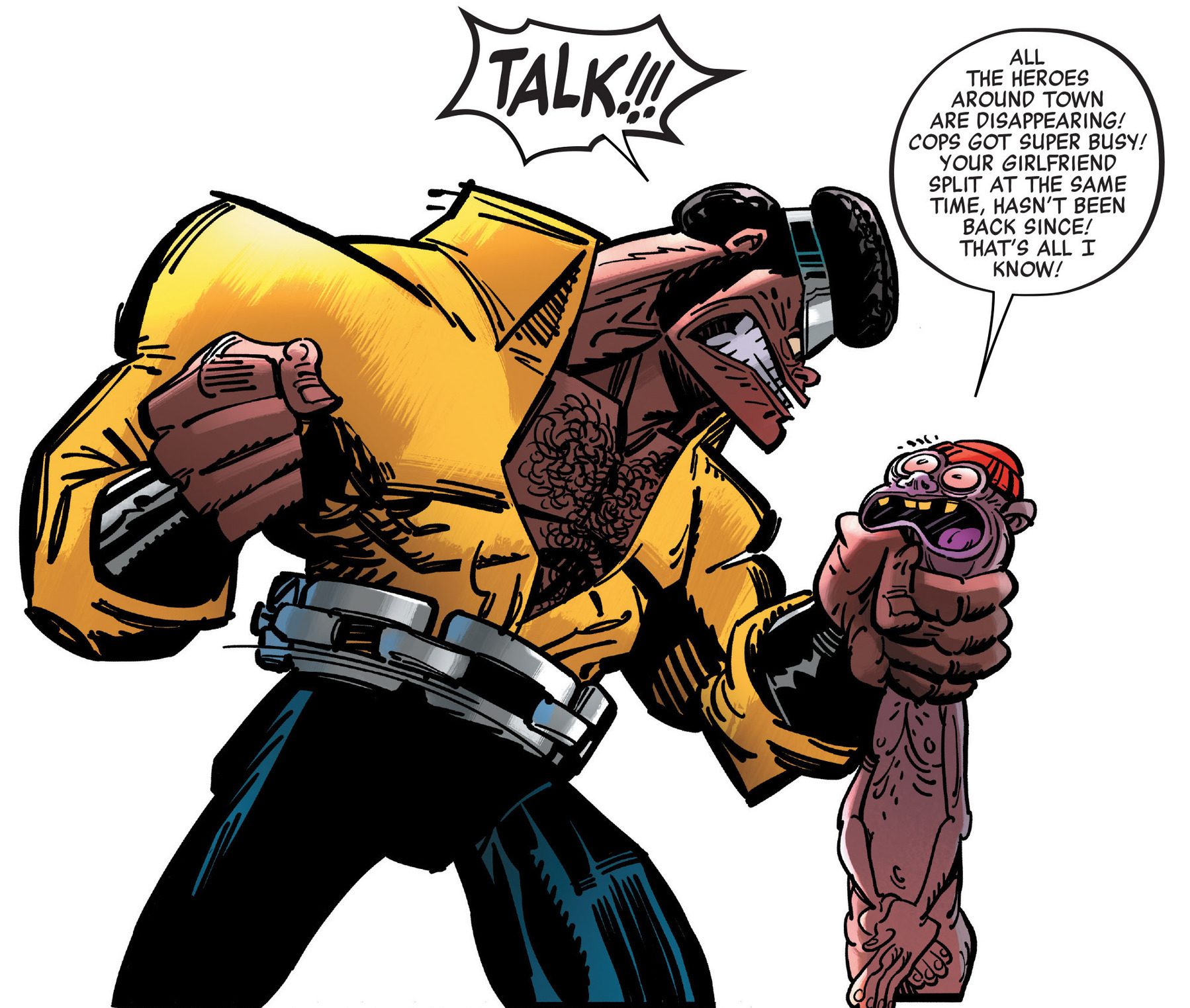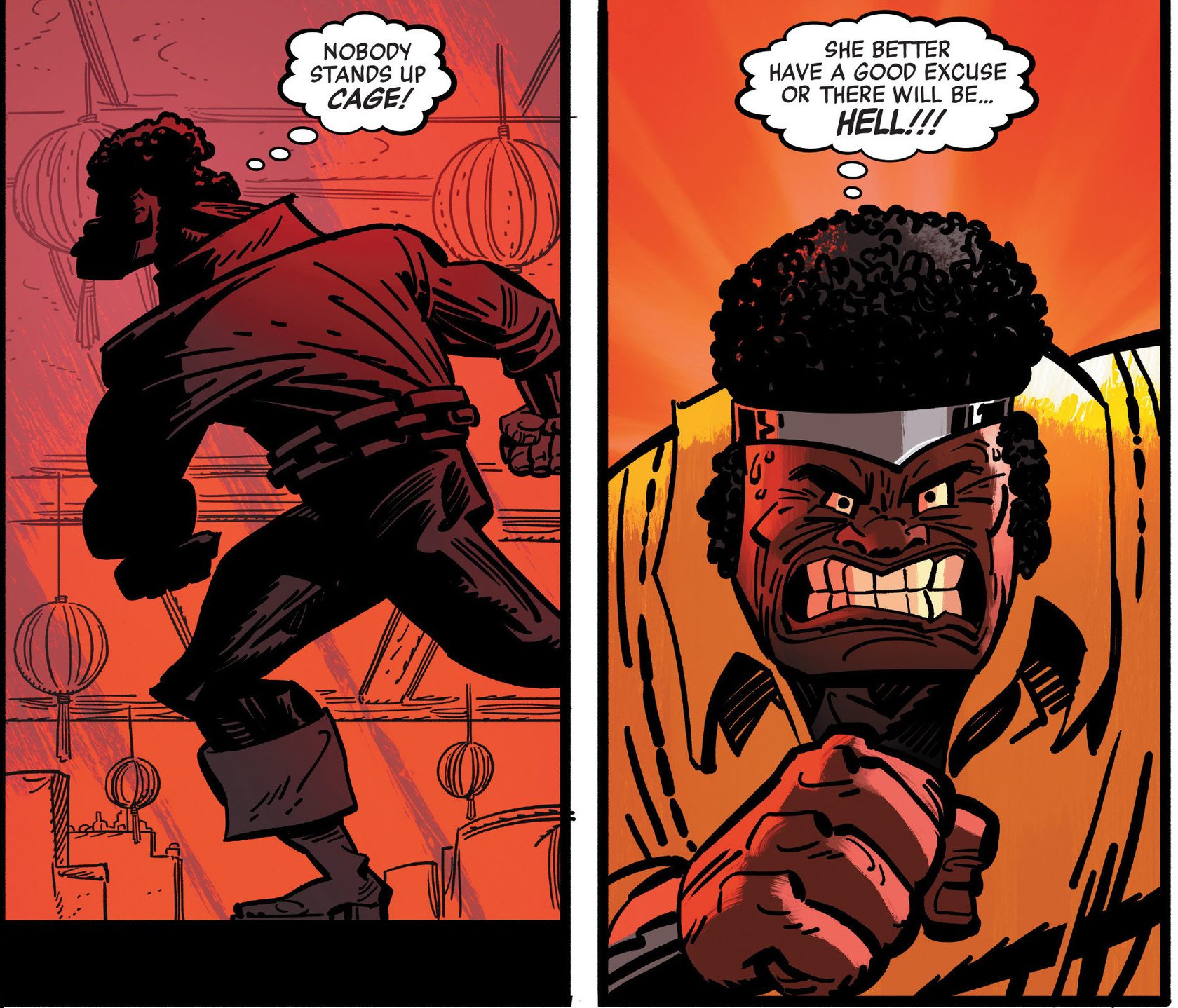Gentrifying Luke Cage: The Racial Failure of Nostalgia
This guest post is part of our new blog series on Comics, Race, and Society, edited by Julian Chambliss and Walter Greason.

In superhero comics, nostalgia is often structural. Woven into the formal codes of serial storytelling, it both supports the production of fantastic visions and undergirds a culture of amnesiac longing. While at times an effective creative tool, within the overwhelmingly white context of superhero comics history, nostalgia is also necessarily a means of maintaining and defending the cultural fantasies of institutionalized white supremacy. The desire to reconstruct some bygone sense of the past, then—especially when expressed amidst the present uniquely black creative moment in the history of mainstream superheroes—should be understood as a form of cultural gentrification: sharp-elbowed white re-imagination that legitimates itself by pushing contemporary black cultural producers from view.
Cage! (2016)—a planned four-issue limited series published by Marvel Comics, with writing and art by renowned cartoon animator Genndy Tartakovsky—shows us exactly what such nostalgia-driven cultural gentrification looks like. It’s a comic book that steals energy from the present black creative moment, substituting instead a purportedly rejuvenated essence of 1970’s-era Marvel. By linking nostalgia for 1970’s-era aesthetics and a kind of garish, depoliticized post-racial fantasy, Cage! fetishizes the Blaxploitation-boom roots of its central character while simultaneously emptying out any potential to reclaim those roots for subversive, critical ends. It exaggerates stereotypical hyper-masculinity and an effusive sense of cool while downplaying the earlier prevalence of systemic critique and Black Power social consciousness. In the growing world of black superheroes, Cage! is a gentrifier’s comic, an apolitical morass, and a racial failure.
Although the project was first announced almost a decade ago, Tartakovsky’s Cage! initially languished in production. When Marvel released the first issue on October 5th, 2016, however, the comic’s titular hero, Luke Cage, was in the middle of a cultural moment. Driven by the excitement surrounding Marvel’s Luke Cage television series, which debuted on Netflix less than a week before Cage! hit the comics shop shelves, Luke Cage had captured the American zeitgeist. Under the guidance of Luke Cage writer-producer Cheo Hodari Coker, it seemed like Power Man, Marvel’s original “Hero for Hire,” had finally arrived. And lots of folks were taking notice.

The public conversations prompted by Coker’s series help us see how Luke Cage has proven a valuable vehicle for expressing political demands in the #BlackLivesMatter era. But Tartakovsky’s Cage is different from its contemporaries, on screen and in the comics. Rather than engage the fertile black political consciousness that surrounds it, Cage! disappoints by locking itself away from challenging political questions or real-world social problems. Instead, it employs the past as a Make-Mine-Marvel playground for the creator’s childhood affinities. “I grew up with comics,” Tartakovsky explained in one 2007 interview, “especially Marvel’s comics – and I always dreamed about doing my own take on one of their preexisting characters.”
With Cage! so situated in the dreamt and imagined past, Tartakovsky explained, “This series takes the essence of Luke Cage and pushes him more in that direction. If we were going to make a Cage film set in the 70’s, this is how it would be.” Thus, Tartakovsky’s storytelling style is a kind of commercial resource extraction, drilling down into the character’s Blaxploitation-era history in search of an “essence” that he can further exploit and amplify.
Taking him at his word, I think it’s clear that Tartakovsky’s concern with identifying the essence of Luke Cage is quintessentially nostalgic. But because his nostalgia is framed personally as “his own take,” he props up his vision as a faithful adaptation of Luke Cage’s essence—a rhetorical move that attempts to establish the authenticity of Tartakovsky’s Cage! as representative of an earlier, truer, version of the character, as well as confirm Tartakovsky’s authority to “push” Cage further in that direction. Nostalgia, in this case, licenses Tartakovsky to sell his vision of a gentrified, post-racial Luke Cage—a vision ostensibly appealing to white audience expectations, for whom a post-racial Blaxploitation narrative can be coherently packaged as “essentially” true.
How does this nostalgia work? Two examples from the first issue are illustrative. First, consider the spare language of the captions on the first page in Cage! In a few short words the story is placed temporally and geographically. Readers are in “1977, New York,” officially set in the story-world. Yet it’s the outsized scale of the “city of big,” with its “big buildings,” “big shoes,” and “big shirts,” that most directly set the scene, which in turn distorts and amplifies the “big crime” in the story. While such spare language might be read simply as a fast-paced establishment of narrative place, the page’s drumbeat emphasis on sheer magnitude does far more work on the visual register, establishing tone, style, and overall feel of the comic.

And it’s the feel of “1977, New York” that’s so troubling. That affective space–the entry into the story-world–is devoid of people (save for shadowy outlines). It’s also lacking any sense of socio-political weight linked to the tension of social movements, police violence, urban ghettoization, and white flight that defined the decade.
Second, when characters are featured in the art, they’re yoked to an exaggerated, rubber-limbed style that highlights the comic’s confused attachment to a post-racial Blaxploitation. Tartakovsky’s rangy figure-work is most effective when communicating theatrical emotion and physical violence. In this way, he references the distortive effects of the original Blaxploitation narrative fueled by largely white audience expectations.
But Tartakovsky goes further, using his art style to amplify some aspects of the original while obscuring others. In one scene, for example, Tartakovsky’s Cage smashes a table, shouting that Misty Knight will have “hell” to pay when he mistakes her missing a dinner date as being stood up. The sequence is jarring—perversely suggesting that, when he confronts Knight, the consequences of his misunderstanding will be violent. In another scene, Tartakovsky’s Cage tortures a prisoner for information, strips him naked, and leaves him beaten in his cell. This is appalling stuff—shifting Cage into the role of an erratic, state-sanctioned, hyper-masculine oppressor—yet in Tartakovsky’s hands they’re breezy plot points. Together, we should read them as the utter failure of this comic’s purported nostalgia for 1970’s-era Marvel. Whatever nostalgia might be here, Cage! forgets more than it claims.
Many comics scholars note that navigating the archetype-laden myth-worlds of superheroes is an unsteady march, and black superheroes seem prone to suspect creative tinkering. Rebecca Wanzo attributes these failures to the fact that “the U.S. superhero body has paradigmatically been white and male, leaving women and people of color to possess liminal status.” Even when present, she argues, women, black folks, and characters of color are subject to pervasive caricature and stereotype. Thus Wanzo asks a perennial question: “How do cultural producers transcend the history of black representation, as these representations inform productions and readings of bodies? Can a comic book character not be read as a stereotype?”

The history of Luke Cage challenges Wanzo’s question, and various iterations of Cage can be read as implicit attempts to answer it—if largely from the margins. A frustrating turn by writer Brian Azzarello and artist Richard Corben in Cage (2002), a five-issue “age of hip-hop” restyling of Luke Cage that Adilifu Nama calls a “nearly unreadable mess” that morphed Cage into a “creepy…ghetto mercenary,” gave way to more nuanced tellings. By the mid-2000s Luke Cage figured centrally at Marvel, notably coming into his modern personality in the pages of writer Brian Michael Bendis’ Alias (2001-2004) and The New Avengers (2005-2010). More recently, in early 2016, writer David F. Walker and artist Sanford Greene rebooted Power Man and Iron Fist—a long running Marvel comic book series from the 1970s originally showcasing Luke Cage. After the first issue went on sale in February, one critic lauded Walker and Greene’s subtly expanding buddy-cop drama as having the “voice and vision” necessary to evolve Luke Cage into a new era, one that “utilizes the past” but isn’t weighed down by it.
Clearly nostalgia can undermine racial stereotypes when it utilizes past narrative as raw storytelling material. But the creative risk is real, and for black superheroes that risk entails a particular kind of racial failure within the white context of American superhero culture. Through its mixed up and questionably inventive nostalgia for Blaxploitation-era Marvel, Cage! shows us such racial failure. Tartakovsky all but abandons the Black Power history of Cage in favor of a gentrified, whitewashing glance backward. As mainstream comics culture increasingly organizes around woke racial politics, Cage! stands out—a retrograde project better left on the shelf.
Joshua Plencner is an assistant teaching professor at Drexel University. His research explores the intersection of American visual culture and the politics of race, with specializations in the study of racial formation in popular culture, affect theory, comics studies, and American Political Development. Follow him on Twitter @joshuaplencner.
Copyright © AAIHS. May not be reprinted without permission.
I found your article on Luke Cage very insightful.